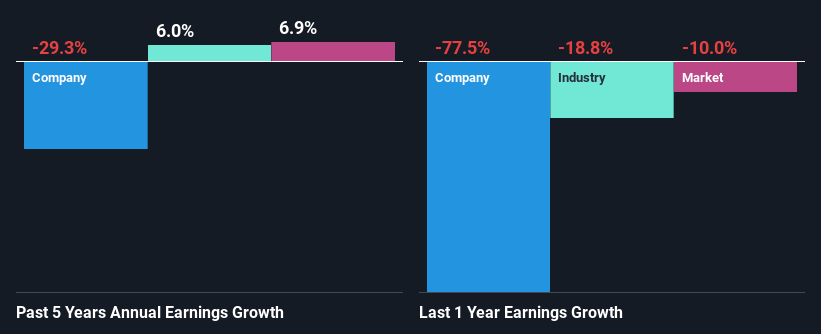Stock Analysis
- New Zealand
- /
- Infrastructure
- /
- NZSE:AIA
Could Auckland International Airport Limited's (NZSE:AIA) Weak Financials Mean That The Market Could Correct Its Share Price?

Auckland International Airport's (NZSE:AIA) stock up by 5.6% over the past three months. Given that the markets usually pay for the long-term financial health of a company, we wonder if the current momentum in the share price will keep up, given that the company's financials don't look very promising. In this article, we decided to focus on Auckland International Airport's ROE.
Return on equity or ROE is a key measure used to assess how efficiently a company's management is utilizing the company's capital. In other words, it is a profitability ratio which measures the rate of return on the capital provided by the company's shareholders.
View our latest analysis for Auckland International Airport
How Do You Calculate Return On Equity?
ROE can be calculated by using the formula:
Return on Equity = Net Profit (from continuing operations) ÷ Shareholders' Equity
So, based on the above formula, the ROE for Auckland International Airport is:
0.5% = NZ$43m ÷ NZ$8.4b (Based on the trailing twelve months to June 2023).
The 'return' refers to a company's earnings over the last year. That means that for every NZ$1 worth of shareholders' equity, the company generated NZ$0.01 in profit.
Why Is ROE Important For Earnings Growth?
We have already established that ROE serves as an efficient profit-generating gauge for a company's future earnings. We now need to evaluate how much profit the company reinvests or "retains" for future growth which then gives us an idea about the growth potential of the company. Assuming all else is equal, companies that have both a higher return on equity and higher profit retention are usually the ones that have a higher growth rate when compared to companies that don't have the same features.
A Side By Side comparison of Auckland International Airport's Earnings Growth And 0.5% ROE
It is quite clear that Auckland International Airport's ROE is rather low. Even compared to the average industry ROE of 4.9%, the company's ROE is quite dismal. Therefore, it might not be wrong to say that the five year net income decline of 29% seen by Auckland International Airport was possibly a result of it having a lower ROE. We believe that there also might be other aspects that are negatively influencing the company's earnings prospects. For instance, the company has a very high payout ratio, or is faced with competitive pressures.
However, when we compared Auckland International Airport's growth with the industry we found that while the company's earnings have been shrinking, the industry has seen an earnings growth of 6.0% in the same period. This is quite worrisome.

The basis for attaching value to a company is, to a great extent, tied to its earnings growth. The investor should try to establish if the expected growth or decline in earnings, whichever the case may be, is priced in. By doing so, they will have an idea if the stock is headed into clear blue waters or if swampy waters await. If you're wondering about Auckland International Airport's's valuation, check out this gauge of its price-to-earnings ratio, as compared to its industry.
Is Auckland International Airport Using Its Retained Earnings Effectively?
With a three-year median payout ratio as high as 136%,Auckland International Airport's shrinking earnings don't come as a surprise as the company is paying a dividend which is beyond its means. Its usually very hard to sustain dividend payments that are higher than reported profits. You can see the 2 risks we have identified for Auckland International Airport by visiting our risks dashboard for free on our platform here.
Additionally, Auckland International Airport has paid dividends over a period of at least ten years, which means that the company's management is determined to pay dividends even if it means little to no earnings growth. Our latest analyst data shows that the future payout ratio of the company is expected to drop to 76% over the next three years. The fact that the company's ROE is expected to rise to 4.1% over the same period is explained by the drop in the payout ratio.
Conclusion
On the whole, Auckland International Airport's performance is quite a big let-down. The low ROE, combined with the fact that the company is paying out almost if not all, of its profits as dividends, has resulted in the lack or absence of growth in its earnings. That being so, the latest industry analyst forecasts show that the analysts are expecting to see a huge improvement in the company's earnings growth rate. To know more about the company's future earnings growth forecasts take a look at this free report on analyst forecasts for the company to find out more.
Valuation is complex, but we're helping make it simple.
Find out whether Auckland International Airport is potentially over or undervalued by checking out our comprehensive analysis, which includes fair value estimates, risks and warnings, dividends, insider transactions and financial health.
View the Free AnalysisHave feedback on this article? Concerned about the content? Get in touch with us directly. Alternatively, email editorial-team (at) simplywallst.com.
This article by Simply Wall St is general in nature. We provide commentary based on historical data and analyst forecasts only using an unbiased methodology and our articles are not intended to be financial advice. It does not constitute a recommendation to buy or sell any stock, and does not take account of your objectives, or your financial situation. We aim to bring you long-term focused analysis driven by fundamental data. Note that our analysis may not factor in the latest price-sensitive company announcements or qualitative material. Simply Wall St has no position in any stocks mentioned.
About NZSE:AIA
Auckland International Airport
Provides airport facilities, supporting infrastructure, and aeronautical services in Auckland and New Zealand.
Moderate growth potential with acceptable track record.


